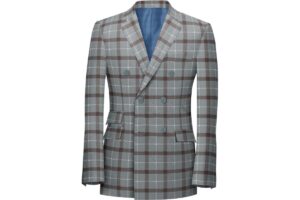The anticipation leading up to a wedding day is filled with joy, excitement, and meticulous planning. Amidst selecting flowers, venues, and vows, one critical aspect that often needs more attention is the groom’s attire. A tuxedo is more than just a suit; it symbolizes elegance, style, and the special significance of the occasion. A well-fitted tuxedo enhances the groom’s appearance and complements the overall wedding aesthetic. This comprehensive guide will walk you through measuring for a tuxedo, ensuring you look impeccable on your big day.
A perfectly fitted tuxedo can elevate your confidence and comfort throughout the event, making you feel at ease and look your best. The right fit enhances your posture, complements your physique, and ensures that you can move freely, whether dancing or mingling. On the other hand, ill-fitting attire can lead to discomfort, restricted movement, and an unflattering appearance in wedding photos, which can be disappointing when looking back on such a significant day. Given the importance of the occasion and the lasting memories captured in photos, investing the time to measure correctly is crucial. Proper measurements can prevent tightness, bagginess, or misaligned seams. Let’s dive into the detailed steps to achieve the perfect fit, ensuring you look sharp and feel great from the ceremony to the reception.
Tools You’ll Need:
- A flexible measuring tape
- A mirror
- A friend or family member to assist
Steps to Measure:
- Chest Measurement:
- Stand upright with your arms relaxed at your sides.
- Wrap the measuring tape around the fullest part of your chest, typically across the nipples.
- Ensure the tape is snug but not tight and parallel to the ground.
- Record the measurement in inches.
- Waist Measurement:
- Locate your natural waist, which is usually just above the belly button.
- Wrap the tape around your waist, making sure it’s comfortably snug.
- Avoid sucking in your stomach to get an accurate measurement.
- Record the measurement in inches.
- Inseam Measurement:
- Stand straight with your legs slightly apart.
- Measure from the top of your inner thigh down to your ankle bone.
- It might be easier to have someone assist with this measurement.
- Record the measurement in inches.
- Sleeve Length Measurement:
- Stand with your arms relaxed at your sides.
- Measure from the top of your shoulder down to your wrist bone.
- Ensure your arm is slightly bent during the measurement.
- Record the measurement in inches.
Read More: How to Measure for a Suit
Tips for Selecting the Right Tuxedo Style
Choosing a tuxedo style depends on various factors, including your body type, the wedding theme, and personal preferences. Here are some comprehensive guidelines to help you make the best choice:
Body Type:
- Slim Build: To accentuate your lean frame, opt for a slim-fit tuxedo. Slim-fit styles often include tapered trousers and fitted jackets, which provide a sleek appearance.
- Athletic Build: A modern or tailored fit will highlight your broad shoulders and narrow waist. Wear tuxedos with structured shoulders and a slightly tapered waist to enhance your athletic silhouette.
- Larger Build: A classic fit tuxedo offers more room and comfort, creating a balanced silhouette. These tuxedos generally have a looser cut in the chest and waist areas, providing ample space for movement.
Wedding Theme:
- Traditional: Classic black or midnight blue tuxedos are timeless choices that never go out of style. Pair these with a crisp white shirt & a black bow tie for a sophisticated look.
- Modern: Experiment with colors like charcoal, burgundy, or even a patterned jacket. Modern styles can also include unique elements like contrasting lapels or textured fabrics.
- Outdoor/Casual: Consider lighter fabrics and colors like gray or tan. Linen or cotton blends are excellent for outdoor or summer weddings, offering comfort and a relaxed vibe.
Personal Preferences:
- Ensure the tuxedo reflects your style and personality. Your tuxedo should make you feel confident and comfortable whether you prefer a classic, modern, or eclectic look.
- Consider different lapel styles (notch, peak, shawl) and accessories (bow ties, cufflinks). Notch lapels are versatile and traditional, peak lapels make a bold statement, and shawl lapels provide a sleek and elegant finish. Accessories like pocket squares, cummerbunds, and personalized cufflinks can add a unique touch to your ensemble.
By thoughtfully considering these factors, you can choose a tuxedo style that ensures you look and feel your best on your special day.
Common Mistakes to Avoid When Measuring for a Tuxedo
Even with precise measurements, certain pitfalls can lead to an ill-fitting tuxedo. Here are some common mistakes and how to avoid them:
- Rounding Off Measurements: Always record exact measurements to avoid discrepancies in fit. Even a slight rounding can result in a tuxedo that feels too tight or loose, affecting overall comfort and appearance.
- Measuring Over Clothes: Measure over a close-fitting shirt or directly on the body for accuracy. Loose or bulky clothing can add extra inches, leading to a tuxedo that doesn’t fit properly.
- Ignoring Posture: Maintain a natural posture during measurements to ensure a comfortable fit. Standing unnaturally straight or slouching can skew the measurements, resulting in a tuxedo that restricts movement or sags in certain areas.
- Overlooking Arm Movement: Ensure the sleeve length allows for free arm movement without excess fabric bunching. The sleeves must provide enough room for activities like reaching and lifting without making the jacket look oversized or sloppy.
By paying attention to these details, you can ensure a tuxedo that fits well and allows for comfort and ease of movement, making you look sharp and feel confident.
The Importance of Professional Fittings and Alterations
While measuring at home is convenient, seeking professional fittings and alterations can make a significant difference in your tuxedo’s overall fit and appearance. Tailors possess the expertise to refine the fit, ensuring the tuxedo complements your body shape perfectly. They can address various aspects, from adjusting the length of the sleeves to taking in the jacket for a more tailored look. Scheduled fittings allow for necessary adjustments, ensuring you look flawless on your wedding day. Additionally, a professional tailor can advise on the best styles and cuts that suit your body type, enhancing your confidence and comfort.
Conclusion
A well-fitted tuxedo is a pivotal aspect of the groom’s wedding attire, contributing to the overall aesthetic and ensuring comfort throughout the event. By following this detailed guide on measuring for a tuxedo, you’ll be well on your way to achieving a perfect fit. Don’t Remember the importance of professional fittings and alterations for a truly polished look.
We’d love to hear about your tuxedo-fitting journey! Share your experiences & tips in the comments below. If you need further advice or assistance, feel free to contact us. Here’s to looking your best on your special day!




No Comment! Be the first one.